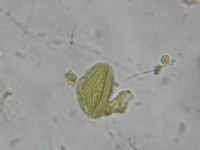Prunus spp - Blackthorn and associated species - Rosaceae
Prunus spinosa is the native Blackthorn. This shrub to small tree with dark grey to black bark and vicious spines grows readily on ground that is not too wet and prefers not to be shaded - it is not generally a woodland tree. The white blossom is amongst the first to open in the spring in February and March, and bears both male and female parts in each flower. Pollination is entomophilous. Pollen grains are between 30 to 40 microns, usually longer than wide.
Pollen grains have a beautiful striation which appears to be lost on full acetylation, and may also be absent from fossil grains. The grains are tricolporate. The preferred orientation of these grains is largely polar when fresh - the pink images below are fresh grains with a light fuchsine stain - while acetylated grains lie equatorially; these are the yellow images below. Note how some actylated grains are losing the outer exine, the striations.
In Prunus cerasifera pollen tubes grow readily from pollen grains as they get older, even while still on the anther. This may occur with P. spinosa as well. Some of the images below are of cultivated Prunus, Prunus cerasifera, Yellow Cherry plum.
Godwin (1956) describes the occurrence of fossil Prunus pollen grains in Great Britain from various interglacials, but in the post glacial period only from Neolithic times onward. However, Prunus has since been associated with Mesolithic sites in Ireland and has a clear correspondence with human habitation, possibly because of the fruit. However, being entomophilous the pollen is not abundant and, combined with the trees preference for drier ground, the pollen would not be expected to be widely found in bog or lake sediments.




















































